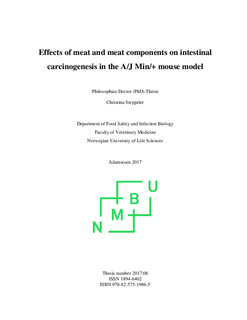| dc.contributor.advisor | Paulsen, Jan Erik | |
| dc.contributor.advisor | Kirkhus, Bente | |
| dc.contributor.author | Steppeler, Christina | |
| dc.date.accessioned | 2017-07-18T12:44:18Z | |
| dc.date.available | 2017-07-18T12:44:18Z | |
| dc.date.issued | 2017 | |
| dc.identifier.isbn | 978-82-575-1986-5 | |
| dc.identifier.issn | 1894-6402 | |
| dc.identifier.uri | http://hdl.handle.net/11250/2448923 | |
| dc.description.abstract | Colorectal cancer (CRC) represents a major public health burden worldwide, and particularly in the developed countries. Sporadic CRC has been associated with a number of lifestyle factors, including smoking, alcohol consumption, physical inactivity, and dietary habits. Despite of being a source for high biological value proteins and essential micronutrients, in 2015, the International Agency for Research on Cancer (IARC) classified red and processed meat as “probably carcinogenic to humans” (Group 2A) and “carcinogenic to humans” (Group 1), respectively. The conclusion was based on evidence from epidemiological investigations that support the association, as well as mechanistic evidence from animal studies. One potential mechanism that may explain the link between red or processed meat and CRC, involves heme iron from red meat. This hypothesis suggests that the ingestion of heme iron may affect the intestinal, epithelial homeostasis by enhancing unfavorable chemical processes, e.g. lipid peroxidation. | nb_NO |
| dc.description.abstract | På verdensbasis, og spesielt i de rike industrilandene har kolorektalkreft (CRC) blitt et folkehelseproblem. Sporadisk CRC har blitt knyttet til livsstilsfaktorer som røyking, alkohol, fysisk inaktivitet og ernæring. Kjøtt er en biologisk høyverdig proteinkilde og kilde til essensielle mikronæringsstoffer. Allikevel ble rødt kjøtt og bearbeidet kjøtt klassifisert som henholdsvis «sannsynlig carcinogen for mennesker» (Gruppe 2A) og «carcinogen for mennesker» (Gruppe 1) av International Agency for Research on Cancer (IARC) i 2015.
Konklusjonen var i hovedsak basert på holdepunkter fra epidemiologiske studier som støtter assosiasjonen, og dyrestudier som undersøkte de mekaniske sammenhengene. En av de foreslåtte mekanismer som forklarer assosiasjonen mellom rødt og bearbeidet kjøtt og CRC er knyttet til hemjern i rødt kjøtt. Hypotesen er at hemjernet fremmer kjemiske prosesser som har en ugunstig effekt på tarmslimhinnen, som for eksempel økt lipid peroksidering. | nb_NO |
| dc.language.iso | eng | nb_NO |
| dc.publisher | Norwegian University of Life Sciences, Ås | nb_NO |
| dc.relation.ispartofseries | PhD Thesis;2017:06 | |
| dc.rights | Attribution-NonCommercial-NoDerivatives 4.0 Internasjonal | * |
| dc.rights.uri | http://creativecommons.org/licenses/by-nc-nd/4.0/deed.no | * |
| dc.subject | Colorectal cancer | nb_NO |
| dc.subject | Heme iron | nb_NO |
| dc.subject | Lipid peroxidation | nb_NO |
| dc.subject | Red meat | nb_NO |
| dc.subject | In vitro digestion | nb_NO |
| dc.title | Effects of meat and meat components on intestinal carcinogenesis in the A/J Min/+ mouse model | nb_NO |
| dc.title.alternative | Effekten av kjøtt og komponenter av kjøtt på kreftutviklingen i tarmen i A/J Min/+ mus modellen | nb_NO |
| dc.type | Doctoral thesis | nb_NO |
| dc.relation.project | Norges forskningsråd: RCN 2244794/E40 | nb_NO |

